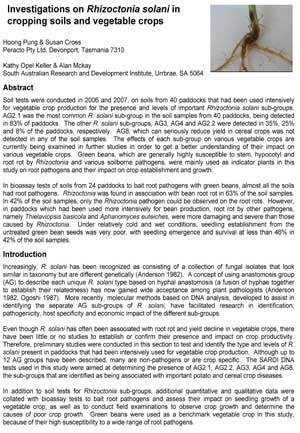|
|
Increasingly, R. solani has been recognized as consisting of a collection of fungal isolates that look similar in taxonomy but are different genetically. A concept of using anastomosis grouping (AG) to describe each unique R. solani type based on hyphal anastomosis (a fusion of hyphae together to establish their relatedness), has now gained wide acceptance among plant pathologists. More recently, molecular methods based on DNA analysis, developed to assist in identifying the separate AG sub-groups of R. solani, have facilitated research in identification, pathogenicity, host specificity and economic impact of the different sub-groups. Even though R. solani has often been associated with root rot and yield decline in vegetable crops, there have been little or no studies to establish or confirm their presence and impact on crop productivity. Therefore, preliminary studies were conducted in this section to test and identify the type and levels of R. solani present in paddocks that had been intensively used for vegetable crop production. Although up to 12 AG groups have been described, many are non-pathogens or are crop specific. In addition to soil tests for Rhizoctonia sub-groups, additional quantitative and qualitative data were collated with bioassay tests to bait root pathogens and assess their impact on seedling growth of a vegetable crop, as well as to conduct field examinations to observe crop growth and determine the causes of poor crop growth. Green beans were used as a benchmark vegetable crop in this study, because of their high susceptibility to a wide range of root pathogens.
In soil tests, the most common type of R. solani sub-group was AG2.1, which was detected in 83% of soils collected from 40 paddocks that had been intensively used for vegetable and potato productions. The effects of each sub-group on various vegetable crops are being examined in further studies, in order to get a better understanding of their impact on crop production. The bioassay tests indicated that root rot could be caused by a range of root pathogens, which may also interact with one another to cause a root disease complex, and which often resulted in a more severe root rot than that caused by a single pathogen. Soil tests developed to detect soilborne pathogens need to cover all the major pathogens in order to be useful for commercial use. In the bioassay tests, Rhizoctonia was found in association with bean root rot in 63% of the soil samples. In 42% of the soil samples, only the Rhizoctonia pathogen was observed on the root rots. However, bean root damage caused by other pathogens, such as Thielaviopsis and Aphanomyces, was more severe than that caused by Rhizoctonia. In the bioassay tests, under relatively cold and wet conditions, seedling establishment from the untreated green bean seeds was very poor. The seedling emergence and survival was less than 46% in approximately 42% of the soil samples. In the field observations, poor crop establishment and growth was associated to root rots, root pathogens, more intensive use of paddocks for bean production and poor soil conditions, as well as poor seed quality. The authors are grateful for the assistance of vegetable growers, Garry McNab of Simplot Australia Pty Ltd, Darren Briggs of McCain Foods and Rob Wilson of Serve-Ag Pty Ltd. We would also like to thank Michael Priest and Andrew Watson of the NSW Department of Primary Industries for confirmation of fungal identification, and the South Australia Research and Development Institute, for Rhizoctonia tests. |
||||||
|

